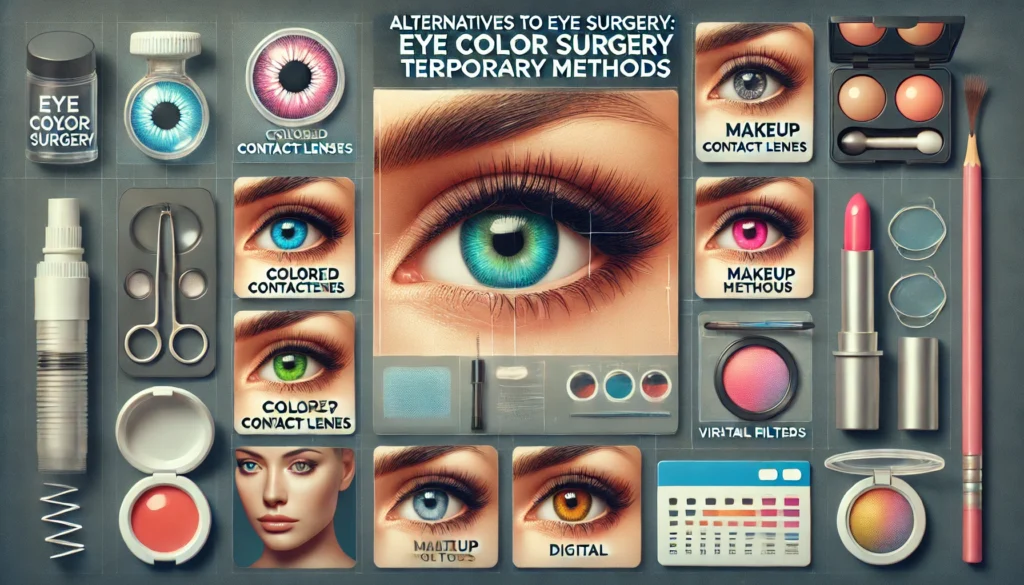Eyes Color Shift

A Comprehensive Overview with Key Data
- A Comprehensive Overview with Key Data
- What Is Eye Color Change Surgery?
- Methods of Eye Color Change Surgery
- Non-Surgical Alternatives for Eye Color Change
- Iris Implant Surgery: The Most Invasive Method
- Is Eye Color Change Surgery Safe?
- Understanding the Costs, Risks, and Eligibility
- Comparisons: Surgery vs. Temporary Methods
- Trends and Social Influence
- Final Thoughts: Is Eye Color Change Surgery Right for You?
Eye color change surgery is an intriguing concept for many, offering the possibility of altering one of the most distinctive features of the human body. While this procedure appeals to those seeking a new aesthetic or personal transformation, it comes with serious considerations, including safety concerns and the availability of different methods. This article will explore the key surgical methods for eye color change, provide important real-world data on risks and historical trends, and offer comparisons with safer, non-surgical alternatives.
What Is Eye Color Change Surgery?
Eye color change surgery involves altering the natural color of your iris through invasive or semi-invasive medical procedures. Commonly, individuals seek these surgeries for cosmetic reasons, though many methods were originally developed to treat medical conditions. In this article, we’ll dive into the details of the three primary methods: keratopigmentation, laser depigmentation, and iris implants, and explore the risks associated with each.
What is Eye Color Change Surgery?
Eye color change surgery involves procedures to permanently alter the iris color. Popular methods include iris implants and laser iris depigmentation.
- Link to full article: What is Eye Color Change Surgery

Methods of Eye Color Change Surgery
Keratopigmentation: Pigment Injection into the Cornea
Keratopigmentation involves injecting pigment directly into the cornea, the transparent outer layer of the eye, to change the appearance of the iris. While this method was originally developed to treat opacities in the cornea or correct conditions like leukoma (a cloudy area on the cornea), it has since been adapted for cosmetic purposes. However, there is limited scientific evidence supporting its safety and efficacy in healthy eyes.
- How it works: A pigment is injected into channels created in the cornea to give the iris a new color.
- Risks: This procedure carries potential risks such as glaucoma, damage to the cornea, and increased intraocular pressure.
- Cost: On average, keratopigmentation can cost $10,000 to $12,000.
FDA Status: It’s important to note that keratopigmentation is not FDA-approved for cosmetic purposes in the U.S. due to safety concerns in healthy individuals. Several ophthalmological societies, including the Sociedad Española de Oftalmología (SEO), have issued warnings against using this procedure for aesthetic reasons.
Image: An illustration showing the keratopigmentation procedure, where pigment is injected into the cornea to alter the iris color.
Laser Depigmentation: A Less Invasive Option
Laser depigmentation offers a less invasive way to change eye color by removing the top layer of melanin in the iris. This method lightens the eyes rather than allowing patients to choose a specific color. It’s ideal for those with darker eyes (like brown) who want a lighter shade (like blue or green).
- How it works: A laser heats and breaks down the melanin in the iris, gradually reducing the eye’s natural pigment.
- Cost: The average cost of this procedure is $5,000 to $7,000.
- Risks: While less invasive than other methods, risks include light sensitivity, inflammation, and unpredictable results. The final color may vary depending on how much pigment is present in the iris.
Link to full article: Laser Eye Color Change: How It Works

One downside of this procedure is that it does not allow for precise color choice—you cannot pick your final eye color as the laser only lightens the existing shade. Additionally, the long-term safety of laser depigmentation is still under review by medical authorities.
Image: A close-up of laser depigmentation, where the outer layer of melanin in the iris is being removed by a precise laser beam.

Eye Color Surgery Recovery Time and Aftercare: A Comprehensive Guide
Non-Surgical Alternatives for Eye Color Change
If you're hesitant about surgery, there are non-invasive methods to consider.
Eye Drops for Eye Color Change
There’s growing interest in eye drops that claim to alter eye color. However, the effectiveness and safety of these drops remain questionable.
- Link to full article: Eye Drops to Change Eye Color

Temporary Methods for Eye Color Change
Temporary options like colored contact lenses allow you to change your eye color without surgery. These methods are safe, reversible, and customizable.
Link to full article: Alternatives to Eye Color Surgery: Temporary Solutions

Iris Implant Surgery: The Most Invasive Method
Iris implant surgery was originally developed to treat conditions such as aniridia (a congenital absence of the iris) or coloboma (a defect in the iris structure). However, the procedure has gained popularity for cosmetic use in certain countries, despite significant risks.
- How it works: A synthetic iris is inserted into the eye through a small incision in the cornea. The implant covers the natural iris and permanently changes the color.
- Risks: This procedure carries severe risks, including increased intraocular pressure, glaucoma, cataracts, and in extreme cases, vision loss or blindness. Due to these risks, iris implants are no longer widely practiced for cosmetic purposes.
Link to full article: Iris Implants Guide

Historical Note: The use of iris implants for cosmetic purposes has diminished significantly due to the high risk of complications, and many surgeons have stopped offering this option for aesthetic reasons.
Image: A surgical procedure where a synthetic iris implant is placed inside the eye to permanently change the eye color.

Is Eye Color Change Surgery Safe?
While the idea of permanently changing your eye color is appealing to some, it is critical to consider the safety concerns that accompany these procedures. Here is a summary of the risks associated with the primary methods:
| Method | Primary Risks |
|---|---|
| Keratopigmentation | Glaucoma, corneal damage, infection, increased intraocular pressure |
| Laser Depigmentation | Light sensitivity, inflammation, unpredictable color outcomes |
| Iris Implants | Glaucoma, cataracts, vision loss, infection, corneal damage |
Several ophthalmology organizations discourage cosmetic eye color surgery, citing the long-term health risks to patients. In addition to the risks outlined above, there is limited evidence to support the safety and efficacy of these procedures for non-medical use.
Understanding the Costs, Risks, and Eligibility
Before opting for surgery, it’s essential to understand the costs, risks, and if you're an ideal candidate.

Eye Color Surgery Eligibility
Not everyone is a good candidate for these surgeries. It depends on your eye health and medical history.
- Link to full article: Who is Eligible for Eye Color Surgery?

Eye Color Surgery Costs
Costs vary depending on the procedure and location, but surgeries can range from $5,000 to $12,000. Explore affordable options.
- Link to full article: Eye Color Surgery Cost and Affordability

Risks of Eye Color Change Surgery
Eye color surgeries come with risks such as infection, vision loss, and increased intraocular pressure. Weigh the pros and cons before proceeding.
Link to full article: Risks and Complications of Eye Color Surgery

Comparisons: Surgery vs. Temporary Methods
If you're considering a change in eye color but are concerned about the risks of surgery, there are temporary methods that are significantly safer and more accessible.
Colored Contact Lenses
Colored contact lenses offer a safe, temporary solution for those who want to change their eye color without surgery. Here’s how they compare to surgical methods:
- Safety: FDA-approved colored lenses are considered safe when prescribed and fitted by a licensed optometrist.
- Cost: A pair of colored contact lenses can range from $30 to $150, making them a much more cost-effective option.
- Flexibility: Unlike surgery, colored contacts allow you to change your eye color as often as you like without any permanent commitment or risk to your vision.
Before and After Eye Color Change Surgery: Everything You Need to Know
The idea of permanently changing eye color has gained popularity in recent years, largely due to the influence of social media platforms like TikTok. Videos and photos showing individuals with dramatically different eye colors have gone viral, sparking curiosity and interest in these procedures.
However, it’s important to recognize that the Sociedad Española de Oftalmología (SEO) and other regulatory bodies have strongly discouraged these procedures for healthy individuals. They recommend against using eye color change surgeries solely for aesthetic purposes due to the potential long-term damage to the eyes.
Final Thoughts: Is Eye Color Change Surgery Right for You?
Ultimately, while the allure of changing your eye color might be strong, it’s crucial to thoroughly consider the risks before deciding on surgery. Whether it’s keratopigmentation, laser depigmentation, or iris implants, each method comes with its own set of challenges and potential complications. For most people, the safer and more flexible option is colored contact lenses, which allow you to experiment with different looks without compromising your long-term eye health.
At EyeColorShift, we’re here to guide you through this process. We offer a wide range of resources and advice on the safest ways to change your eye color. Contact us today for more information or to explore non-invasive options that meet your aesthetic goals without the risks associated with surgery.
